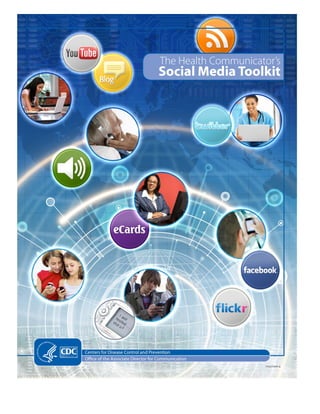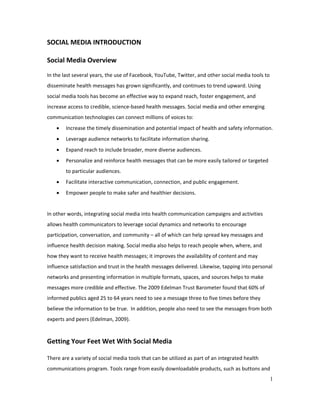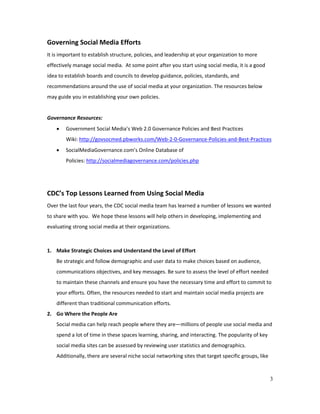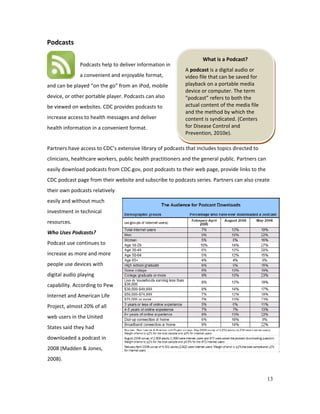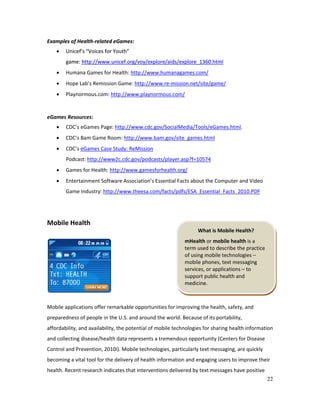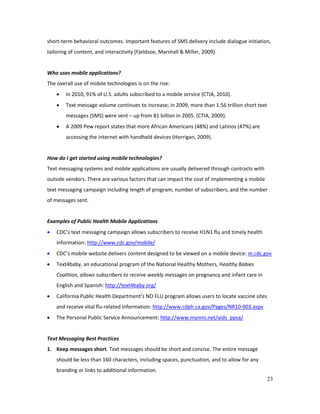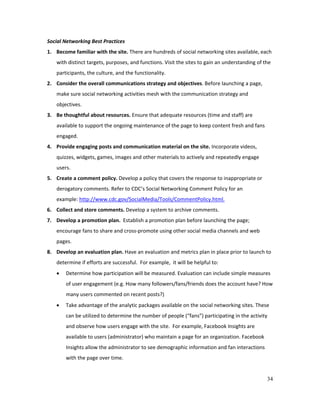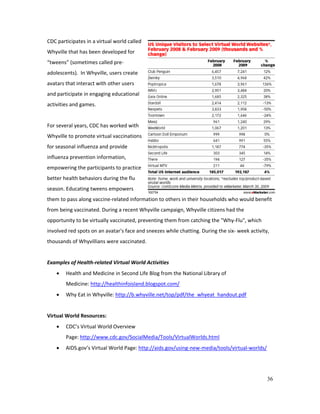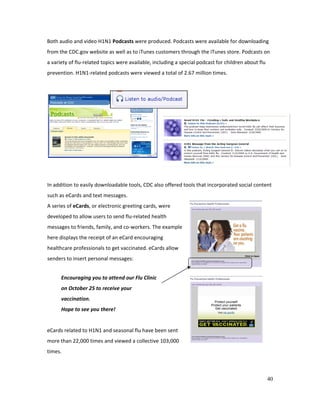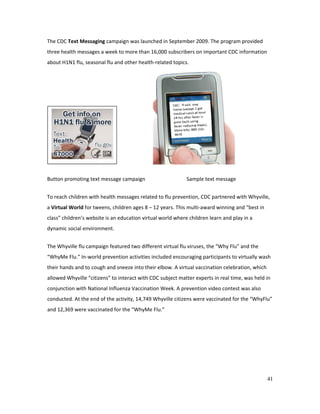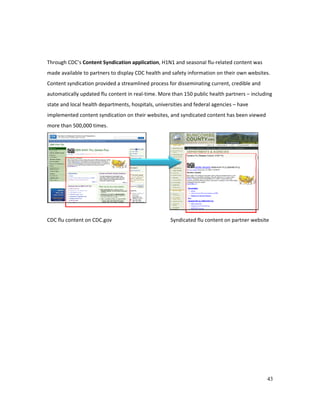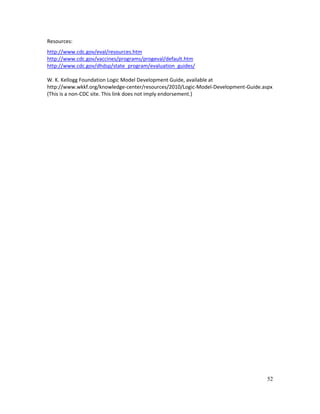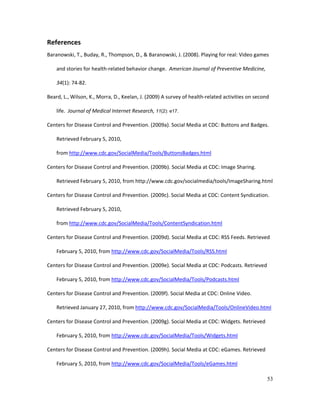CDC Social Media Toolkit
- 3. Social Media Introduction Social Media Overview 1 Getting Your Feet Wet With Social Media 1 Governing Social Media Efforts 2 CDC’s Top Lessons Learned from Using Social Media 3 Developing a Social Media Strategy 5 Social Media Tools Buttons and Badges 8 Image Sharing 9 Content Syndication 11 RSS Feeds 12 Podcasts 13 Online Video Sharing 15 Widgets 18 eCards 19 Electronic Games 21 Mobile Health 22 Micro‐blogs 25 Blogs 28 Social Networking Sites 32 Virtual Worlds 35 Social Media Campaign Example 2009 – 2010 H1N1 and Seasonal Flu Outbreak Campaign 37 More Social Media Resources 45 Social Media Communications Strategy Worksheet 46 Social Media Evaluation Worksheet 49 References 52 A guide to using social media to improve reach of health messages, increase access to your content, further participation with audiences and advance transparency to improve health communication efforts. August 6, 2010
- 5. SOCIAL MEDIA INTRODUCTION Social Media Overview In the last several years, the use of Facebook, YouTube, Twitter, and other social media tools to disseminate health messages has grown significantly, and continues to trend upward. Using social media tools has become an effective way to expand reach, foster engagement, and increase access to credible, science‐based health messages. Social media and other emerging communication technologies can connect millions of voices to: • Increase the timely dissemination and potential impact of health and safety information. • Leverage audience networks to facilitate information sharing. • Expand reach to include broader, more diverse audiences. • Personalize and reinforce health messages that can be more easily tailored or targeted to particular audiences. • Facilitate interactive communication, connection, and public engagement. • Empower people to make safer and healthier decisions. In other words, integrating social media into health communication campaigns and activities allows health communicators to leverage social dynamics and networks to encourage participation, conversation, and community – all of which can help spread key messages and influence health decision making. Social media also helps to reach people when, where, and how they want to receive health messages; it improves the availability of content and may influence satisfaction and trust in the health messages delivered. Likewise, tapping into personal networks and presenting information in multiple formats, spaces, and sources helps to make messages more credible and effective. The 2009 Edelman Trust Barometer found that 60% of informed publics aged 25 to 64 years need to see a message three to five times before they believe the information to be true. In addition, people also need to see the messages from both experts and peers (Edelman, 2009). Getting Your Feet Wet With Social Media There are a variety of social media tools that can be utilized as part of an integrated health communications program. Tools range from easily downloadable products, such as buttons and 1
- 7. Governing Social Media Efforts It is important to establish structure, policies, and leadership at your organization to more effectively manage social media. At some point after you start using social media, it is a good idea to establish boards and councils to develop guidance, policies, standards, and recommendations around the use of social media at your organization. The resources below may guide you in establishing your own policies. Governance Resources: • Government Social Media’s Web 2.0 Governance Policies and Best Practices Wiki: http://govsocmed.pbworks.com/Web‐2‐0‐Governance‐Policies‐and‐Best‐Practices • SocialMediaGovernance.com’s Online Database of Policies: http://socialmediagovernance.com/policies.php CDC’s Top Lessons Learned from Using Social Media Over the last four years, the CDC social media team has learned a number of lessons we wanted to share with you. We hope these lessons will help others in developing, implementing and evaluating strong social media at their organizations. 1. Make Strategic Choices and Understand the Level of Effort Be strategic and follow demographic and user data to make choices based on audience, communications objectives, and key messages. Be sure to assess the level of effort needed to maintain these channels and ensure you have the necessary time and effort to commit to your efforts. Often, the resources needed to start and maintain social media projects are different than traditional communication efforts. 2. Go Where the People Are Social media can help reach people where they are—millions of people use social media and spend a lot of time in these spaces learning, sharing, and interacting. The popularity of key social media sites can be assessed by reviewing user statistics and demographics. Additionally, there are several niche social networking sites that target specific groups, like 3
- 8. moms, physicians, or racial and ethnic groups, or sites that focus on a particular topic like travel or health. 3. Adopt Low‐Risk Tools First If you are starting out and finding resistance to using social media among your communication team or stakeholders, it may be helpful to first adopt low‐risk solutions and later build on your successes. Products such as podcasts, videos, and widgets are easily downloadable, and can be accessed from partner sites and posted on your website. 4. Make Sure Messages Are Science‐based As with any effective health communication, messages developed for dissemination through social media channels should be accurate, consistent, and science‐based. 5. Create Portable Content Develop portable content—such as widgets and online videos—that can easily extend reach beyond your website to provide credible, timely, and accurate content for partners and others who want to help spread your health messages. 6. Facilitate Viral Information Sharing Make it easy for people to share your messages and become health advocates. This can be accomplished by using social media sites such as Facebook and YouTube that encourage sharing among users, or you can use tools with sharing features, like widgets or eCards. 7. Encourage Participation Social media allows for the tailoring of messages to help express empathy and acknowledge concern, promote action, and listen to what people are saying about health‐related topics in your community. Two‐way conversations can foster meaningful communication with your audiences that can help to facilitate relationships, sharing, and interaction. 8. Leverage Networks Social media allows people to easily establish networks that they can access on a regular basis. For example, Facebook reports the average Facebook user has 130 friends, or a network of 130 people with whom they can easily share information, and may choose to share your health messages (Facebook. 2010). By strategically leveraging these established networks you can facilitate information sharing and in turn, expand the reach of your message. 4
- 9. 9. Provide Multiple Formats Providing messages in multiple formats increases accessibility, reinforces messages, and gives people different ways to interact with your content based on their level of engagement and access to media. 10. Consider Mobile Phones Over ninety percent of adults in America subscribe to mobile services. Therefore, mobile technologies such as text messaging and mobile websites offer an opportunity to rapidly reach a large percentage of your audience members no matter where they are. 11. Set Realistic Goals Social media can raise awareness, increase a user’s knowledge of an issue, change attitudes, and prompt behavior change in dynamic, personalized, and participatory ways. However, like traditional communication, social media alone may not be able to meet all of your communication goals or address all of the target audiences’ needs. Set your goals accordingly. 12. Learn from Metrics and Evaluate Your Efforts Digital communications offer many metrics that you can use to focus and improve your communications efforts. Metrics can help you to report usage, monitor trends, and gauge the success of specific promotions or outreach efforts. Beyond simple metrics, social media efforts can also be evaluated by measuring the use of information, engagement, and participation of people with your content, and its health impact. Monitoring trends and discussions on social media networks can also be a valuable way to better understand current interest, knowledge levels, and potential misunderstandings or myths about your health topic. Developing a Social Media Strategy A social media communication strategy should be only one part of a larger communication effort, and social media needs to be integrated into overall communication planning, activities and data collection. Therefore, over‐arching communication goals should be considered when developing social media activities. As with all media outreach, the keys to effective social media outreach are identifying target audience(s), determining objective(s), knowing outlet(s) and deciding on the amount of resources (time and effort) that can be invested. However, with 5
- 10. social media more information can be obtained through a particular media channel to help build your strategy. For example, with social media you can listen to conversations in real time, and identify influencers and fans. You can better understand audience needs in specific social media spaces and engage users in new ways. Having clear communication objectives will help build your strategy. For example, you will probably need different strategies for each campaign. Because the objectives for each campaign are different, the way you exchange ideas, collaborate with partners, or encourage behavior change will also be different. Likewise, understanding your audience(s) will help you determine the channel selection and how you use specific channels. People access information in different ways, at different times of the day, and for different reasons. Defining your audience needs using market research, metrics, and other data will be important to determining the channels you want to use. Each channel is different and has differing engagement, content, and community norms. Understanding the way people naturally use or participate in social media channels is also very helpful in determining your strategy. Resources: • Social Media Communications Strategy Worksheet on page 46. • "Knowing Your Audience & Doing Market Research" from Webcontent.gov: http://www.usa.gov/webcontent/improving/evaluating/audience.shtml • Pew Internet and American Life Project: http://www.pewinternet.org/ • CDC eHealth Data Briefs: http://www.cdc.gov/HealthMarketing/ehm/databriefs/ 6
- 11. SOCIAL MEDIA TOOLS CDC uses social media to provide users with access to credible, science‐based health information when, where, and how users want it. A variety of social media tools are used to reinforce and personalize messages, reach new audiences, and build a communication infrastructure based on open information exchange. There are three key attributes of social media channels that are believed to make them highly effective as health communication tools: • Personalization – content tailored to individual needs. • Presentation – timely and relevant content accessible in multiple formats and contexts. • Participation – partners and the public who contribute content in meaningful ways. Additionally, many social media channels facilitate social engagement, viral sharing of information, and trust. There are a number of social media tools that you can utilize in your health communications activities—more than what is listed here, in fact. While we did not cover every social media tool available, this section of the toolkit should provide you with an understanding of a wide range of social media tools CDC and others in public health have successfully used in emergency response efforts, major campaigns, and other health communication, promotion and media efforts. 7
- 12. Buttons and Badges What are Buttons and Badges? Buttons are graphic elements that usually include an image, a short call‐to‐action message, and a link for more information. They are CDC has a large gallery of buttons and badges, small often created to be shared, and include HTML code that allows web graphics or images, which can be utilized by them to be posted on a website. partners to share health information about Badges are also small graphic campaigns and causes online. Go to our gallery images that include a message and which includes graphics on a number of health link to a web page. However, badges are often posted on an topics, including specific campaigns and national individual's social network profile public health activities. To add a button or badge to or personal blog to show support for or affiliation with a cause or your website, social networking profile or blog, issue, and may include messages simply copy and paste the code assigned to the that show a personal action was taken (e.g. "I got tested." instead image in the gallery. of "Get tested.") (Centers for Disease Control and Prevention, 2010a). Buttons and badges can help promote activities and increase awareness about health topics, and can be produced fairly easily and with little resources. CDC provides guidance and best practices for creating buttons and badges. (The link is listed in Resource section below.) Six Simple Tips to Creating Great Campaign Images: 1. Create graphics in several sizes, including standard ad sizes, and sizes developed specifically for your web pages. 2. Write a simple, yet catchy, health message that stands alone. 3. Use colorful and attractive images or designs that can be viewed on a number of sites and in a number of sizes. 4. Be sure to include a URL on the image and a link back to your website. 5. Promote the use of the images and review metrics to learn more about the effectiveness of your efforts. 6. Review the CDC’s Guidelines and Best Practices for Developing Buttons and Badges listed in the resource section below for more tips. 8
- 13. Resources: • CDC’s Button and Badge Gallery: http://www.cdc.gov/socialmedia/tools/buttonsgallery.html • CDC’s Button and Badge Overview Page: http://www.cdc.gov/SocialMedia/Tools/ButtonsBadges.html • CDC’s Guidelines and Best Practices for Developing Buttons and Badges: http://www.cdc.gov/SocialMedia/Tools/guidelines/pdf/buttonbadge.pdf. Image Sharing What is Image Sharing? Image sharing involves posting images (photos, artwork, etc.) to public websites where they can be viewed, tagged, categorized, and even used by others. Image sharing provides value to health (Centers for Disease Control and Prevention, 2010b). communication activities by providing public health images that users can easily use on websites, blogs or other social media sites. As content creation continues to improve on social media channels and on the internet as a whole, the need for fresh graphics and engaging content also increases. Posting images people can easily share helps engage people and allows for greater access to health content. There are several online communities that provide image sharing services. For instance, Flickr and Shutterfly provide a platform for posting images that can be organized around health topics. CDC shares images on both Flickr and the Public Health Image Library (PHIL), which offers an organized, universal gateway to CDC pictures. These can be used for reference, 9
- 14. teaching, presentations, and public health messages that partners can access to find images to post on their sites. Likewise, CDC’s photostream on Flickr includes public health photos and graphics developed for public health events that users can comment on and share. Partners can also easily and cost‐effectively create accounts on a number of available image sharing sites, producing images to upload and sharing images. A Few Simple Tips to Image Sharing Success: • When establishing your account, use a name that will resonate with your users and follows naming and branding guidelines. It is also a good idea to include information on your profile page about your agency or program. If possible, also include a link back to your organization’s website to drive traffic to your website. • Think about your audience when choosing images. What kinds of images will be most helpful to them or best portray your communication objectives? If relevant, ensure your images are culturally‐appropriate. • Be thoughtful about selecting, naming, describing, and tagging images. Do you need to post all of the images available or will posting only the best images serve the viewers better? • Consider engaging online communities and encouraging viewers to add tags, notes, and comments. Image Sharing Resources: • CDC’s Image Sharing Page: http://www.cdc.gov/SocialMedia/Tools/ImageSharing.html. • AIDS.gov’s Facing AIDS for World AIDS Day Flickr FAQs: http://blog.aids.gov/2009/11/facing‐aids‐for‐world‐aids‐day‐flickr‐faqs.html • American Red Cross 2010 Earthquake in Haiti: http://www.flickr.com/photos/americanredcross/sets/72157623078316465/ • Flickr Best Practices in Government: https://forum.webcontent.gov/resource/resmgr/flickr_best_practices_gui de.pdf 10
- 15. Content Syndication What is Content Syndication? Content Syndication is a technical application that enables partner organizations to display current CDC health and safety content and allows visitors to the public health partner’s website access to CDC content without leaving the partner website. This tool, provided by CDC, allows the CDC syndicates a wide range of health‐related topics communication and management of the latest of content on CDC.gov, including seasonal flu, chronic science‐based information disease, and emergency preparedness information. online. (Centers for Disease Control and Prevention, 2010b). Many topic web pages are also available in Spanish. Prevention, 2010c). Hundreds of partners already utilize content syndication to provide accurate web content that is automatically updated on their web sites when it is updated on CDC.gov. Content Syndication is an easy and cost‐free way for public health partners to provide credible, timely, and science‐based health information to their audiences. Partners can self‐register to quickly search available content topics at CDC.gov, select from the online catalog, and download syndication code. In addition to improved reach and access to health information, content syndication also helps enable citizens to create innovative health applications by providing easier access to government tools, data and information. CDC began content syndication in November 2007, and has found it to be a successful way to provide vital government information to the public and collaborate with valuable public health partners. Resources: • CDC’s Content Syndication Registration System: http://tools.cdc.gov/register/ • CDC’s Listing of Syndication Topics: http://tools.cdc.gov/register/pages.aspx 11
- 16. RSS Feeds What is an RSS Feed? CDC RSS feeds enable partners to RSS stands for Really Simple personalize the health information Syndication. RSS feeds provide they receive by subscribing to the an easy way to stay updated on information that is important to topics of greatest interest to them. Public health you and helps reduce the time it partners also have the option of posting the feeds on takes to browse or search for new information on web sites. their websites to allow their users access to up‐to‐ RSS feeds provide updated news date CDC information. More than 25 unique RSS headlines, blog posts or selected Web site content. (Centers for feeds are available from CDC, including Spanish‐ Disease Control and Prevention, language feeds. 2010d). To utilize this content, you will need an RSS‐enabled browser or an RSS news reader to subscribe. These tools help you view the content and will let you know when there is new content. You can also use content from RSS feeds by adding a feed to your website or social media space. Adding an RSS feed to a page is a rapid, low‐cost way to provide up‐to‐date health news to your viewers. Likewise, creating an RSS feed of your content is not very difficult technically, and it can be a low‐risk way to start working in social media. Resources: • Subscribe to a CDC RSS Feed: http://www2c.cdc.gov/podcasts/rss.asp • CDC’s Overview of RSS Feeds Page: http://www.cdc.gov/SocialMedia/Tools/RSS.html • AIDS.gov’s Putting the Simple in Real Simple Syndication (RSS Feeds): http://blog.aids.gov/2008/01/rss‐feed.html • WebContent.gov’s RSS Feeds Page: http://www.usa.gov/webcontent/technology/rss.shtml • WhyRSS.com’s Really Simple Guide to RSS: http://www.whyrss.com/ • Common Craft's RSS in Plain English provides a brief overview of RSS feeds: http://www.commoncraft.com/rss_plain_english 12
- 17. Podcasts What is a Podcast? Podcasts help to deliver information in A podcast is a digital audio or a convenient and enjoyable format, video file that can be saved for and can be played “on the go” from an iPod, mobile playback on a portable media device or computer. The term device, or other portable player. Podcasts can also “podcast” refers to both the be viewed on websites. CDC provides podcasts to actual content of the media file and the method by which the increase access to health messages and deliver content is syndicated. (Centers health information in a convenient format. for Disease Control and Prevention, 2010e). Partners have access to CDC’s extensive library of podcasts that includes topics directed to clinicians, healthcare workers, public health practitioners and the general public. Partners can easily download podcasts from CDC.gov, post podcasts to their web page, provide links to the CDC podcast page from their website and subscribe to podcasts series. Partners can also create their own podcasts relatively easily and without much investment in technical resources. Who Uses Podcasts? Podcast use continues to increase as more and more people use devices with digital audio playing capability. According to Pew Internet and American Life Project, almost 20% of all web users in the United States said they had downloaded a podcast in 2008 (Madden & Jones, 2008). 13
- 18. Examples of Health‐Related Podcasts A number of healthcare organizations provide podcasts, including: • The World Health Organization provides public health information and related news from around the world: http://www.who.int/mediacentre/multimedia/podcasts/en/ • Seattle Children’s Hospital’s podcast on flu vaccinations for children: http://www.seattlechildrens.org/videos/flu‐vaccinations‐for‐children/ • PKIDs also provides a number of podcasts for Parents of Kids with Infectious Diseases: http://itunes.apple.com/us/podcast/id218493791 • CDC provides hundreds of podcasts, including a number on a variety of health and safety topics: http://www2c.cdc.gov/podcasts/browse.asp Eight Best Practices for Podcast Production 1. Define the purpose. Identify the target audience, the main health messages and communication goal prior to developing content. 2. Create audience relevant content. Designing a podcast with a particular audience in mind requires careful consideration of content. Podcasts designed to reach health professionals may contain medical terminology whereas those for the general public should make use of common terms such as chicken pox instead of varicella. This is particularly important with podcasts, since listeners or viewers may have downloaded the podcast for listening or viewing on a personal device and not able to access the internet or a dictionary. 3. Consider length. There is no hard and fast rule that dictates the recommended length of a podcast. It is helpful to consider the communication goals and the target audience. Some messages can be effectively communicated in five or ten minutes while other topics may require a longer podcast to explain adequately. 4. Develop a release schedule and post frequently. Podcasts that are part of a series with frequent releases have a broader listener base. 5. Utilize cross‐marketing. To increase exposure for podcast episodes or series, leverage a variety of existing and no‐ or low‐cost channels. External podcast directories allow podcast registration, and users can search by keyword and category. Consider adding a button on other web pages directing people to the Podcast URL. 14
- 19. 6. Provide additional information. Direct the listener to more information or resources related to the topic by fully articulating all URLs mentioned in the podcast. This will be useful for many users, but keep in mind that other people may listen to podcasts while they are away from a computer, or are unable to write, so the content should stand alone without additional information. 7. Connect with the audience. Careful selection of a host ensures a connection with the audience. Often a Q&A format will help listeners to better understand the topic by providing natural breaks during the discussion. 8. Evaluate your podcasting activities. For example, you can collect basic information on how many times each podcast is downloaded or played. Additionally, if user comments and ratings are a part of the podcasting system, you can track them to guide future podcast development. Podcasting Resources: • To review CDC’s podcast library or subscribe, please see http://www2c.cdc.gov/podcasts • CDC’s Overview of Podcasts Page: http://www.cdc.gov/SocialMedia/Tools/Podcasts.html. • Podcast FAQ a website committed to providing everything you need to know about podcasting, has a wealth of information on podcasting: http://www.podcastfaq.com/ • WebContent.gov’s Podcast Page: http://www.usa.gov/webcontent/technology/podcasting.shtml Online Video Sharing What is Online Video Sharing? Online video sharing can be used by partners to share tailored health communication messages. Online video sites, such as YouTube, MSN and Yahoo have emerged as popular and powerful video sharing sites. (Centers for Disease Control and Prevention, 2010f) 15
- 20. Online video sharing can be a great way to exchange information, share personal stories, and engage audiences. Because anyone with internet access can upload, view, share, and comment on video footage, video sharing is becoming immensely popular. Using video sharing sites like YouTube or Google Video to disseminate tailored health education and health communication messages helps provide an engaging experience for consumers to view and share health and safety information. With people watching over 100 million clips a day on YouTube alone, (Hurley, 2009) these online video sources can be a powerful mechanism to assist you in distributing current and accurate science and health messages (Centers for Disease Control and Prevention, 2010g). CDC’s official YouTube channel, CDC Streaming Health, contains CDC‐produced videos on a variety of health topics. With an internet connection, partners can upload, view, share and comment on video footage. Partners can also easily upload a number of CDC‐produced videos to their websites or other social media spaces, like a blog or Facebook page. Similarly, you can easily create a channel on a video sharing site to disseminate videos created by your organization. Who Uses Video‐sharing Sites? Overall, the use of video sharing sites has nearly doubled from 2006 – 2009. Among social media tools, watching online videos is more prevalent than the use of social networking sites. Users tend to be young adults in the 18 – 29 age group. However, there have been steady increases over the last year in viewing among internet users in the 30 – 49 and over 50 age groups as well (Madden, 2009). YouTube is the most popular video sharing site, with more than 103.8 million unique monthly visitors in May 2010, up from 81.4 million in May 2009 (Siteanalytics, 2010). Examples of Health‐related Video‐sharing Sites • CDC‐TV Video Sharing site: www.cdc.gov/CDCTV • CDC YouTube Channel: http://www.youtube.com/CDCstreaminghealth • Children’s Hospital of Philadelphia: http://www.youtube.com/watch?v=7CrvznJOt2I • Immunization Action Coalition: http://www.youtube.com/user/ImmunizationAction • Juvenile Diabetes Foundation: http://www.youtube.com/user/jdrfonline • eHowHealth: http://www.youtube.com/user/ehowhealth 16
- 21. Six Best Practices for Online Video Production 1. Prepare content that is appropriate for your target audience. Content should be engaging, visually pleasing, and presented at a level appropriate for the target audience. For instance, the use of jargon, technical information, or detailed charts and graphs should be avoided. Simple, easy‐to‐follow “stories” with a single message or call to action are more likely to become “viral,” a term referring to when viewers voluntarily share links or embed videos on their own websites, blogs, and social networking profiles. 2. Keep the videos short. Check the technical requirements for the site being utilized for video posting. The majority of video sharing sites will have time limits on the length of the video. CDC data show that many users start dropping off after three minutes. 3. Create a promotional plan. List the video‐sharing site(s) where you plan to post the video, partners to help you disseminate it, the web pages on your site where the video will be embedded, and other social spaces – like MySpace, Facebook or Twitter – where you can post and promote it. 4. Choose music appropriately. Music you use should be purposeful and thoughtful, and complement the intended message. Unless you plan to pay for music, choose selections that are copyright free. 5. Include a URL for more information. Include a specific URL at the end of the video to direct the user to additional information on the topic. 6. Evaluate. As with all communications activities, evaluation is important. Depending on the site utilized for video posting, metrics may be provided to assist with the evaluation. For instance, you may be able to measure or track: • The number of times each video has been viewed • Viewer ratings and comments • Channel subscribers • Points in the video when viewership drops off Video Sharing Resources: • YouTube ‐ http://www.youtube.com/ • Google Video ‐ http://video.google.com/ • Yahoo! video ‐ http://video.yahoo.com/ 17
- 22. • For more information on online video at CDC, please see: http://www.cdc.gov/SocialMedia/Tools/OnlineVideo.html • See CDC’s YouTube and OnlineVideoGuidelinesand Best Practice for additional information: http://www.cdc.gov/SocialMedia/Tools/guidelines/pdf/onlinevideo.pdf Widgets What is a Widget? Made popular by Google, Facebook, A widget is an application that can be utilized by partners to display and providers such as Widgetbox, featured health content directly widgets provide interactive on their desktop, website or social media site. Widgets can also information and fresh content with generally be shared with friends. minimal user maintenance. The (Centers for Disease Control and Prevention, 2010g). content in a widget can be updated automatically, ensuring access to up‐to‐ date and credible health and safety content. CDC provides a number of widgets (in both English and Spanish) on a variety of health topics, including H1N1 and seasonal flu, smoking and tobacco use, an adult BMI calculator, and everyday health tips. These and many other widgets can easily be added to partner pages or social media sites to provide an interactive experience, fresh content, and engagement with important health topics. To add a CDC widget to your site, locate a widget at www.cdc.gov/widgets and click on "Share." A new screen will display the html code for that particular widget. Simply cut and paste the html code into your web page. Who Uses Widgets? According to an October 2008 Razorfish report, 55% of “connected consumers” (or those who report using a broadband connection to the internet and the use of digital media) add widgets on their desktops, and 62% use them on sites such as Facebook and iGoogle. 18
- 23. How Do I Start Developing a Widget? There are programs online that allow anyone to create a widget. However, if you want a customized one, you will most likely need to hire someone with specific technical, usability, and design skills to develop it. Examples of Health‐related Widgets • CDC.gov: http://www.cdc.gov/widgets/ • Healthfinder.gov: http://www.healthfinder.gov/widgets/ • NIH.gov: http://www.nih.gov/widgets.htm • 3‐DPregnancy.com’s Baby & Pregnancy Countdown Ticker: http://3dpregnancy.parentsconnect.com/widget/ • Get Yourself Tested Locator Widget: http://www.itsyoursexlife.com/gyt‐week?utm_source=gytnow Widget Resources • CDC’s Widgets Overview Page: http://www.cdc.gov/SocialMedia/Tools/Widgets.html eCards What is an eCard? eCards are electronic greeting cards that are sent to people’s eCards are an effective and inexpensive way to reach email accounts. CDC developed individuals with personalized and targeted health Health‐e‐Cards to encourage healthy behavior by information. People can use eCards to send a communicating programs, personal message as well as health messages to their products and information to individuals. (Centers for Disease friends and family. An eCard often opens with a Control and Prevention, 2010e). colorful greeting, and includes a message that encourages healthy living, promotes safe activities, or celebrates a health‐ and safety‐related event. CDC provides a large collection of Health‐e‐Cards with more than 200 cards on a wide range of health topics. eCards can be directed to clinicians, healthcare workers, public health practitioners and the general public. Partners can utilize CDC’s eCards to send personal health 19
- 24. messages to their audiences. Partners also have the option to post thumbnail images and links to CDC eCards on their websites, connecting their users to the CDC eCard application where individuals can personalize and send cards to their friends, family and co‐workers. Who Uses eCards? eCards are popular with Americans of all ages. According to the Greeting Card Association, an estimated 500 million e‐cards are sent each year worldwide (Greeting Card Association, 2010). Examples of Health‐related eCards • CDC.gov: http://www.cdc.gov/eCards/ • Healthfinder.gov: http://www.healthfinder.gov/ecards/DisplayCard.aspx?CardID=20 • Tobacco Free California: http://www.tobaccofreeca.com/ecards.html • InSpot’s STD Notification eCards: http://www.inspot.org/TellThem/tabid/58/language/en‐US/Default.aspx Six Tips for Developing eCards 1. Define the purpose. Identify the target audience, the key health messages, and communication goals prior to developing content. 2. Create content relevant to your audience. Designing an eCard with a particular audience in mind requires careful consideration of content. There are two audiences to consider when developing eCards—the sender and the recipient. eCards should contain messaging and images considered appropriate for sending and receiving by friends, family members, or colleagues. 3. Include URL for more information. Include a specific URL inside the eCard to direct the recipient to additional information on the topic. Once links are determined, develop a short text description that is a call to action for the hyperlinked text. 4. Utilize cross‐marketing. To increase exposure for new eCards, leverage a variety of existing and no‐cost channels, including your website and other social media channels. 5. Evaluate. As with all communications activities, evaluation is important. Depending on your web analytics software, metrics may be available to assist with the evaluation. For instance, you may be able to measure or track: • The number of times each eCard has been sent and viewed. 20
- 25. • The number of clickthroughs from the eCard to your website. The number of clickthroug from the eCard to your website. 6. Review the CDC’s Guidelines and Best Practices for Developing eCards listed in the resource Review the CDC’s Guidelin and Best Pra ces for veloping eCards listed in the resour section below for more tips. ection below for more tips. eCard Resources: eCard Resources: • CDC’s Health‐e‐Cards: CDC’s Health‐ Cards: http://www2c.cdc.gov/ecards/ http://www2c.cdc.gov/ecards/ • CDC’s eCards Overview Page: http://www.cdc.gov/SocialMedia/Tools/eCards.html • CDC’s Guidelines and Best Practices for Developing eCards: http://www.cdc.gov/SocialMedia/Tools/guidelines/pdf/ecards.pdf Electronic Games What are eGames? eGames can reach new audiences Electronic games, or eGames, are with pertinent and targeted interactive games that are played health messages. In fact, eGames through an electronic application such as the Internet, a video have been shown to influence positive health‐related game console, or a mobile phone. changes in a variety of target audiences and for a Centers for Disease Control and Prevention, (2009h). Prevention, (2009h). number of health issues (Baranowski, Buday, Thompson & Baranowski, 2008). How Do I Start Developing an eGame? Generally, eGames take significant skill and resources to develop. If you choose to develop an eGame, there are a number of groups and organizations that specialize in games for health or serious games. Who Uses eGames? Two‐thirds of American households play computer or video games, according to the Entertainment Software Association. Almost all teens play eGames and the average game player’s age in 2010 is 34 years of age (26% of gamers are over 50 years of age in 2010). More men play games, but women are catching up. (Entertainment Software Association, 2010) 21
- 26. Examples of Health‐related eGames: • Unicef’s “Voices for Youth” game: http://www.unicef.org/voy/explore/aids/explore_1360.html • Humana Games for Health: http://www.humanagames.com/ • Hope Lab’s Remission Game: http://www.re‐mission.net/site/game/ • Playnormous.com: http://www.playnormous.com/ eGames Resources: • CDC’s eGames Page: http://www.cdc.gov/SocialMedia/Tools/eGames.html. • CDC’s Bam Game Room: http://www.bam.gov/site_games.html • CDC’s eGames Case Study: ReMission Podcast: http://www2c.cdc.gov/podcasts/player.asp?f=10574 • Games for Health: http://www.gamesforhealth.org/ • Entertainment Software Association’s Essential Facts about the Computer and Video Game Industry: http://www.theesa.com/facts/pdfs/ESA_Essential_Facts_2010.PDF Mobile Health What is Mobile Health? mHealth or mobile health is a term used to describe the practice of using mobile technologies – mobile phones, text messaging services, or applications – to support public health and medicine. medicine. Mobile applications offer remarkable opportunities for improving the health, safety, and preparedness of people in the U.S. and around the world. Because of its portability, affordability, and availability, the potential of mobile technologies for sharing health information and collecting disease/health data represents a tremendous opportunity (Centers for Disease Control and Prevention, 2010i). Mobile technologies, particularly text messaging, are quickly becoming a vital tool for the delivery of health information and engaging users to improve their health. Recent research indicates that interventions delivered by text messages have positive 22
- 27. short‐term behavioral outcomes. Important features of SMS delivery include dialogue initiation, tailoring of content, and interactivity (Fjeldsoe, Marshall & Miller, 2009). Who uses mobile applications? The overall use of mobile technologies is on the rise: • In 2010, 91% of U.S. adults subscribed to a mobile service (CTIA, 2010). • Text message volume continues to increase; in 2009, more than 1.56 trillion short text messages (SMS) were sent – up from 81 billion in 2005. (CTIA, 2009). • A 2009 Pew report states that more African Americans (48%) and Latinos (47%) are accessing the internet with handheld devices (Horrigan, 2009). How do I get started using mobile technologies? Text messaging systems and mobile applications are usually delivered through contracts with outside vendors. There are various factors that can impact the cost of implementing a mobile text messaging campaign including length of program, number of subscribers, and the number of messages sent. Examples of Public Health Mobile Applications • CDC’s text messaging campaign allows subscribers to receive H1N1 flu and timely health information: http://www.cdc.gov/mobile/ • CDC’s mobile website delivers content designed to be viewed on a mobile device: m.cdc.gov • Text4baby, an educational program of the National Healthy Mothers, Healthy Babies Coalition, allows subscribers to receive weekly messages on pregnancy and infant care in English and Spanish: http://text4baby.org/ • California Public Health Department’s NO FLU program allows users to locate vaccine sites and receive vital flu‐related information: http://www.cdph.ca.gov/Pages/NR10‐003.aspx • The Personal Public Service Announcement: http://www.mynmi.net/aids_ppsa/ Text Messaging Best Practices 1. Keep messages short. Text messages should be short and concise. The entire message should be less than 160 characters, including spaces, punctuation, and to allow for any branding or links to additional information. 23
- 28. 2. Make messages engaging. Write relevant, timely, clear, and actionable messages. Try to begin each message with an interesting fact or question so that users will be more likely to open the text message to read the rest of the information. 3. Make content readable. All content should be written at no higher than an 8th grade reading level. 4. Use abbreviations sparingly. Because text messages have a character limit, it is acceptable to use abbreviations, but only when they are easily understood and do not change the meaning of the message. 5. Limit Latin characters. Please note that non‐Latin or accented letters do not always work, depending on the mobile carrier. 6. Provide access to additional information. Include your organization name in the text so users know who is sending the message. Include a way for users to follow up or respond to the message, such as a phone number and/or URL to a mobile website. Links to traditional websites should be avoided. All phone numbers should be formatted so the user can click‐ to‐call the number automatically from their cell phone. All URLs should include the “http://” as not all phones work without this. 7. Include opt‐out options. Text messages may also include information on how to opt‐out of the text messaging program. These characters also need to be figured into the maximum length of 160 characters. 8. Promote your text messaging efforts. Create a promotion plan that includes promoting on mobile sites, social media, and other spaces. 9. Evaluate your efforts. Evaluation can be accomplished with surveys and metrics reviews. Standard survey message testing can look at quality, clarity, the strength of the message, as well as the effectiveness of the message. When evaluating text messaging activities, there are many ways to evaluate the effort: • Collect basic metrics on how many users are signed up for the program and how many users take part in interactive messaging efforts. • If possible, collect demographic data about users: age, sex, geographic location. • Survey users to gather information on what types of messages they prefer, and use information to shape messages for your text messaging program. • When possible, use surveys (via text messaging or by sending users to a web survey) to evaluate changes in knowledge, attitude, and behavior. 24
- 29. Mobile Resources • CDC’s Text Messaging Guidance: http://www.cdc.gov/SocialMedia/Tools/guidelines/pdf/textmessages.pdf Guidance: http://www.cdc.gov/SocialMedia/Tools/guidelines/pdf/textmessages.pdf • CTIA – The Wireless Association: http://www.ctia.org/aboutCTIA/ • Mobile Marketing Association: http://mmaglobal.com/main • Mobile Health News: http://mobihealthnews.com/ • Fierce Mobile Healthcare ‐ http://www.fiercemobilehealthcare.com/ ‐ Weekly newsletter that provides the latest news on the rapidly evolving mobile healthcare environment. • Pew Internet & American Life Project’s Mobile Access to Data and Information: http://www.pewinternet.org/Reports/2008/Mobile‐Access‐to‐Data‐and‐Information.aspx Micro‐blogs What is a Micro‐blog? Micro‐blogging allows users to post brief text updates to a website that aggregates these messages for viewing by friends or the public. These messages can be submitted by a variety of CDC uses Twitter to seek and share health and safety means, including text messages, mobile websites, or the website information in real time with people interested in hosting the micro‐blog. While CDC’s health topics. Twitter has become an several micro‐blogging sites exist, Twitter is the most popular. important platform for connecting people interested in specific health and safety information. Twitter What is Twitter? Twitter is an online micro‐ isn’t just about broadcasting information; it also blogging and social networking provides opportunities to listen and gather website that provides real‐time information, commentary, and information. Twitter’s search engine descriptions of events. Twitter (http://search.twitter.com) is a great tool for users send updates, or "tweets," that are 140 characters or less in monitoring conversations on any given topic on length and displays on their Twitter – it is generally limited to the past 2 weeks of profile page and in their and in their follower’s feed. Twitter users follower’s feed. Twitter users public tweets. can also highlight certain audio can also highlight certain udio or video content. or video content. 25
- 30. Who uses Twitter? Individuals, organizations (e.g. American Cancer Society), corporations (e.g. CNN, Microsoft) and federal agencies (e.g. National Institutes of Health and CDC) all use Twitter. Due in large part to its increasing use within the business community and among news outlets, the early adopters of Twitter are not from the younger generation as is usually the case with other social media tools (Leggatt, 2009). Recently, this application has become a more mainstream activity as an increasing number of celebrities have joined. Still, the largest population of Twitter users are in the 18 – 34 age bracket (44%), followed by the 35 – 49 age group (28%). Females represent 53% of users, and 43% have children ages 0 – 17 in their household (Quantcast, 2010c). Examples of Twitter Profiles Addressing Public Health • CDCeHealth: http://twitter.com/CDC_eHealth • AIDS.gov: http://twitter.com/AIDSgov • Minority Health: http://twitter.com/MinorityHealth • CA IZ Coalition: http://www.twitter.com/Immunizeca • CBC Health (Canada): http://twitter.com/CBCHealth Twitter Best Practices 1. Account set‐up recommendations ‐ Profile Name, Image and Biography a. Profile name ‐ Each Twitter account has a unique profile name that describes the subject matter of the account, name of the organization or contains a keyword describing the nature of the organization. (e.g. CDC_eHealth, FluGov). The profile name should be short and concise (maximum 15 characters). b. Biography ‐ The biography is a 160‐character description of the profile. This biographical statement should be the first post from a new profile. c. Image – A logo or graphic that represents your organization or agency. 2. Keep content short and simple. CDC recommends writing tweets of 120 characters so that messages can easily be retweeted, (the practice of posting another user’s tweet), without 26
- 31. editing. If a tweet contains the maximum 140 characters, users who want to share your message by retweeting will need to edit the message to reduce the character count. 3. Provide more information with a shortened URL. If possible, provide a link back to your main website for more information. You can save space by using URLs that are shorter. Several websites are available that can help you: http://tinyurl.com, http://is.gd or http://tr.im. 4. Promote your Twitter profile. Provide links to your Twitter profile on other communications materials that you have prepared, including both traditional and social media, and work with other Twitter profiles to build your audience base strategically. 5. Keep followers engaged. Setting a regular posting schedule will help engage followers. 6. Post other relevant content. Develop a strategy for retweeting posts from partners and followers. 7. Search Twitter for comments about your organization or health topic: You can use search.twitter.com for ways of monitoring Twitter. You can then “listen” to conversations about important health concerns, find messages about your organization, and monitor how audiences are responding to messages. 8. Evaluate your efforts. Track your efforts and regularly review the number of followers, updates, retweets, and mentions in Twitter. Also, there are a number of ways to monitor increased traffic to your website, as well as the “mentions” outside of Twitter on blogs, websites or articles. With regular monitoring of Twitter efforts, it is easy to track increased traffic to your website generated by click‐throughs of your links, changes in your followers, and the amount of retweets of your messages. Many evaluation metrics for Twitter can be collected for little or no cost. When evaluating micro‐blogging activities, consider the following: • Track click‐throughs from your links: Website analytics software (such as Omniture Site Catalyst or Google Analytics), allows you to track increases in website traffic from Twitter by measuring how many followers click through from Twitter links back to your site. • Analyze influence on Twitter: Account users may keep track of how many other users are “following” them and how many updates they have published over time. Users may access http://search.twitter.com to search for retweets, @replies (or “at replies”), and 27
- 32. other mentions of his or her Twitter username. An RSS feed can also be set up to track these search results. • Analyze followers: Because micro‐blogging sites are web‐based, it may be possible to design an online survey (through a tool such as SurveyMonkey) to measure user satisfaction, increases in knowledge due to your profile, or changes in behavior or attitudes. Twitter Resources: • CDC.gov Social Media Tools: Micro‐ blogs: http://www.cdc.gov/SocialMedia/Tools/MicroBlogs.html • CDC’s Social Media Tools Guidance on Micro‐ Blogging: http://www.cdc.gov/SocialMedia/Tools/guidelines/pdf/microblogging.pdf • WebContent.gov’s Twitter Best Practices: http://www.usa.gov/webcontent/technology/microblogging/twitter.shtml Blogs What is a Blog? Blogs, or web logs, are regularly updated online journals that almost anyone with an internet connection can use. Some blogs target a small audience, while others boast a readership comparable to national newspapers. They may have only one author or a team of regular authors, but most blogs share a similar format in that the entries are posted in a reverse chronological order and may allow readers to comment on posts (Centers for Disease CDC often wants to share content in a way that Control and Prevention, 2010j). Blogs often focus on a specific allows readers to leave comments and engage in topic or type of topic. discussion. A blog can be used to discuss a topic that 28
- 33. may be too complex for a tweet or Facebook post, and to give your topic or program a more personal and engaging presence than a website allows. Who is blogging? “Overall, bloggers are a highly educated and affluent group. Nearly half of all bloggers we surveyed have earned a graduate degree, and the majority have a household income of $75,000 per year or higher” (Sussman, 2009). A closer look at the demographics indicates that two‐thirds are male, 60% are in the 18 – 44 age group and more than half are parents. Health‐related Blogging Examples: • School Kids Healthcare Blog: (http://www.schoolkidshealthcareblog.com/) This blog targets school nurses, healthcare and safety professionals, and campus medical staff – allowing them to connect with their peers, discuss current events, and share stories and challenges (School Kids Health Care Blog, 2010). • Shot of Prevention: (http://shotofprevention.com/) This is a community blog where individuals, parents, medical professionals and others can gather to discuss questions and current events regarding immunizations (Shot of Prevention Blog, 2010). • Consumer Reports Health Blog: (http://blogs.consumerreports.org/health/healthy_living/) A blog focusing on a variety of consumer health topics including nutrition, treatment options, and prevention tips. • American Society for Nutrition: (http://www.nutrition.org/asn‐blog/) A blog devoted to the sharing of reliable nutrition information. • Massachusetts Department of Health: (http://publichealth.blog.state.ma.us/) A blog focusing on health topics in the state, including Spanish language posts by the Director of Ethnic Media Engagement. Bloginars: Another method for reaching bloggers, is hosting blogger webinars, or “bloginars” to reach out to bloggers and provide information about outbreaks or public health events. Each bloginar features a presentation by a subject matter expert, a presentation of relevant social media products, and provides attendees an opportunity to ask questions. 29
- 34. Blogging Best Practices: 1. Observe the blogosphere. Before beginning a blog of your own, read other blogs that deal with similar topics to learn what works well and who the “influencers” are in the topic area. One can find blogs through the blog search engines such as Technorati (www.technorati.com). 2. Provide links. Support posts with links to other web pages that provide context to your post. 3. Keep posts as short as possible. Provide enough information to support main points, but be succinct. Shorter posts (a couple of paragraphs) are more likely to be read in their entirety than longer posts. However, if an issue is particularly complex, it may require a longer post. 4. Make headlines attention‐grabbing. Just like a newspaper article, a blog post’s title should capture a reader’s attention and summarize the main point of the post. Look to national newspapers to get ideas for writing headlines. 5. Include numbered or bulleted lists. List structured information in an easily digestible format. 6. Make posts easy to scan. Insert sub‐headings where applicable and make sentences and headlines short and to the point. “Chunking” information makes it easier for important information to stand out. 7. Keep a consistent style. Readers like to know what to expect. Find a writing style that works for the intended audience and maintain it throughout each blog post. Since this can be difficult when working with a team of authors, appoint one person to review all posts for style and consistency. 8. Use keywords strategically. Think about what keywords people would use to search for a post and include them in the body text and headers. Make sure the keyword placement is natural and does not seem out of place. 9. Edit your post. Good writing is in the editing. Before hitting the submit button, re‐read the post and edit for brevity and clarity. 10. Promote your blog. Have a promotion plan in place before launching a blog. If Twitter is a part of your overall communication strategy, it can be a good place to promote a new post. Sending direct email updates to partners and those who have shown interest in the organization can also be a great way to promote a blog. 30
- 35. 11. Determine how to handle comments. Will you allow readers to leave responses or comments about the blog? If so, consider how these will be monitored. Have a protocol in place regarding how to handle responses. 12. Make use of web analytics tools. Two popular web analytics tools to consider using are listed below: • Google Analytics ‐ http://www.google.com/analytics/ • Yahoo! Web Analytics – http://web.analytics.yahoo.com/ It is advised to review your policy and privacy implications before utilizing any analytic tools. 13. Evaluate your efforts. Using a web analytics tool allows you to determine the number of people who have visited the page in a particular time period. It is also important to track the number of comments received on each blog post. It is especially useful to look for patterns in blog posts that draw the most comments and determine if the length, topic, or time of day you posted the blog draws more reader engagement. Utilizing official blogger software allows a blog to be catalogued by blog search engines, such as Technorati (www.technorati.com). Technorati also assigns an “authority” number to blogs it catalogues. The “authority” refers to the number of websites linking to a blog in the previous six months. A higher “authority” means that more people are linking to a blog, which may help to show the blog’s popularity and, in some cases, credibility. Technorati also allows a user to search for other blogs that may be linking to his or her blog. Blogger Resources: • For more information on blog activities at CDC, please see: http://www.cdc.gov/SocialMedia/Tools/Blogs.html • For more information on how CDC has used bloginars, please visit http://www.cdc.gov/SocialMedia/Tools/Bloginars.html • Technorati (http://www.technorati.com/search) • Google Blog Search (http://blogsearch.google.com/) • Blogger: http://www.blogger.com • Common Craft video “Blogs in Plain English”: http://www.commoncraft.com/blogs • Probloggers “Starting Out in Blogging from Scratch”: http://www.problogger.net/archives/2008/03/18/if‐you‐were‐starting‐out‐in‐ blogging‐from‐scratch‐how‐would‐you‐promote‐your‐blog/ 31
- 36. • Probloggers “23 Questions for Prospective Bloggers”: http://www.problogger.net/archives/2006/02/14/is‐a‐blog‐right‐for‐you/ • CDC.gov Social Media Tools: Bloginars http://www.cdc.gov/SocialMedia/Tools/Bloginars.html Social Networking Sites What is a Social Networking Site? Social networking sites are online communities where people can interact with friends, family, coworkers, acquaintances, and others with similar interests. Most social networking sites provide multiple ways for their Social networking sites are very popular and are users to interact such as chat, email, video, voice chat, file‐ being used by millions of people every day to sharing, blogging, and discussion interact, share, and learn. On Facebook alone, users groups. spend almost an hour a day on the site. Social networking sites provide an immediate and personal way to deliver programs, products, and information. By far the most popular social networking site is Facebook, which has just reached over 400 million users (July 2010). Other popular sites include MySpace, Linkedin, and Foursquare. There are also hundreds of niche social networking sites that target audiences like moms and physicians, or address topics like travel or health issues. Who Uses Social Networking Sites? There has been tremendous growth in social networking site use since 2005. In fact, “46% of online American adults 18 years old and older use a social networking site like MySpace, Facebook and LinkedIn, up from 8% in February 2005” (Lenhart, 2009). Additional demographic information about social networking sites include: Facebook User Profile: (Quantcast, 2010a) • 55% female • Highest percentage of users in the 13 – 34 year age group 32
- 37. • 46% have children 0 – 17 in household • 42% are college graduates • Facebook users are generally more affluent (58% have annual incomes over $60,000) • Caucasian users make up 75% of users while 11% are African Americans MySpace User Profile: (Quantcast 2010b) • 51% male • 58% are 18 – 34 • 42% have children 0 – 17 in their households • 64% have no college education • MySpace users are considered middle income with 44% of users in the $30,000 ‐ $60,000 income bracket • 26% of MySpace users are African Americans Examples of Social Networking Sites Addressing Public Health Topics • Colorado Children’s Immunization Coalition: http://www.facebook.com/ImmunizeCOKids • American Cancer Society: http://www.facebook.com/AmericanCancerSociety?v=wall&ref=ts • AIDS.gov MySpace: http://www.myspace.com/aidsgov • Nebraska Department of Health and Human Services: http://www.facebook.com/pages/Lincoln‐NE/Nebraska‐Department‐of‐Health‐ and‐Human‐Services/340846025779?v=wall&ref=ts# • Alabama Department of Public Health: http://www.facebook.com/pages/Montgomery‐ AL/Alabama‐Department‐of‐Public‐Health‐ADPH/235001560006 • Philadelphia Department of Public Health Flu: http://vids.myspace.com/index.cfm?fuseaction=vids.individual&VideoID=100208789 • CaringBridge: http://www.facebook.com/CaringBridge • PatientsLikeMe: http://www.patientslikeme.com/ 33
- 38. Social Networking Best Practices 1. Become familiar with the site. There are hundreds of social networking sites available, each with distinct targets, purposes, and functions. Visit the sites to gain an understanding of the participants, the culture, and the functionality. 2. Consider the overall communications strategy and objectives. Before launching a page, make sure social networking activities mesh with the communication strategy and objectives. 3. Be thoughtful about resources. Ensure that adequate resources (time and staff) are available to support the ongoing maintenance of the page to keep content fresh and fans engaged. 4. Provide engaging posts and communication material on the site. Incorporate videos, quizzes, widgets, games, images and other materials to actively and repeatedly engage users. 5. Create a comment policy. Develop a policy that covers the response to inappropriate or derogatory comments. Refer to CDC’s Social Networking Comment Policy for an example: http://www.cdc.gov/SocialMedia/Tools/CommentPolicy.html. 6. Collect and store comments. Develop a system to archive comments. 7. Develop a promotion plan. Establish a promotion plan before launching the page; encourage fans to share and cross‐promote using other social media channels and web pages. 8. Develop an evaluation plan. Have an evaluation and metrics plan in place prior to launch to determine if efforts are successful. For example, it will be helpful to: • Determine how participation will be measured. Evaluation can include simple measures of user engagement (e.g. How many followers/fans/friends does the account have? How many users commented on recent posts?) • Take advantage of the analytic packages available on the social networking sites. These can be utilized to determine the number of people (“fans”) participating in the activity and observe how users engage with the site. For example, Facebook Insights are available to users (administrator) who maintain a page for an organization. Facebook Insights allow the administrator to see demographic information and fan interactions with the page over time. 34
- 39. • Consider tracking the amount of traffic being driven to a website from an organization’s Facebook page. If using an analytics tool for a website (such as Google Analytics or WebTrends), that tool will show the source of traffic to a page, and the number of users who are visitors coming via a link on the Facebook page. • Plan to evaluate with an online survey (through a tool such as SurveyMonkey) to measure user satisfaction, increases in knowledge due to the social networking page, or changes in behavior or attitudes. Social Networking Resources: • CDC’s Social Networking Guidance and Best Practices: http://www.cdc.gov/SocialMedia/Tools/SocialNetworking.html • Facebook for Government: http://www.facebook.com/government • Common Craft video “Social Networks in Plain English”: http://www.commoncraft.com/video‐social‐networking • WebContent.gov Social Networks and Government: http://www.usa.gov/webcontent/technology/social_networks.shtml • GovLoop: http://www.govloop.com/ (A government community) Virtual Worlds What is a Virtual World? A virtual world is an online environment where users can create a virtual persona, or avatar, and interact with other avatars in a created online virtual environment. In recent years, Virtual worlds provide an immersive experience virtual worlds have become where users can get health information and practice increasingly popular with growing numbers of participants healthy behaviors. Research in health who enjoy the immersive communication demonstrates that behaviors from experience. (Centers for Disease Control and Prevention, 2010k). virtual worlds can translate to the real world. Real‐ life behaviors can be influenced for users who engage in a range of health‐related activities in virtual worlds (Beard, Wilson, Morra & Keelen, 2009). 35
- 40. CDC participates in a virtual world called Whyville that has been developed for “tweens” (sometimes called pre‐ adolescents). In Whyville, users create avatars that interact with other users and participate in engaging educational activities and games. For several years, CDC has worked with Whyville to promote virtual vaccinations for seasonal influenza and provide influenza prevention information, empowering the participants to practice better health behaviors during the flu season. Educating tweens empowers them to pass along vaccine‐related information to others in their households who would benefit from being vaccinated. During a recent Whyville campaign, Whyville citizens had the opportunity to be virtually vaccinated, preventing them from catching the "Why‐Flu", which involved red spots on an avatar's face and sneezes while chatting. During the six‐ week activity, thousands of Whyvillians were vaccinated. Examples of Health‐related Virtual World Activities • Health and Medicine in Second Life Blog from the National Library of Medicine: http://healthinfoisland.blogspot.com/ • Why Eat in Whyville: http://b.whyville.net/top/pdf/the_whyeat_handout.pdf Virtual World Resources: • CDC’s Virtual World Overview Page: http://www.cdc.gov/SocialMedia/Tools/VirtualWorlds.html • AIDS.gov’s Virtual World Page: http://aids.gov/using‐new‐media/tools/virtual‐worlds/ 36

